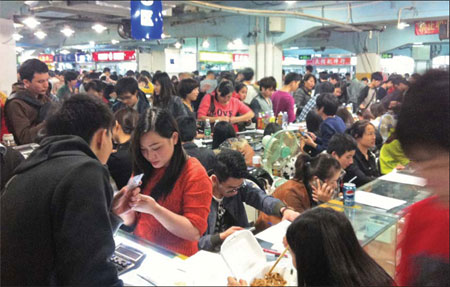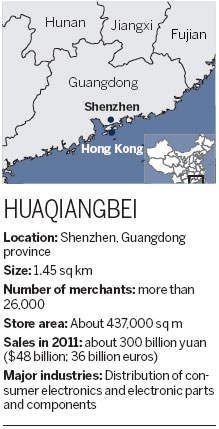
|
Clockwise from above: Though Huangqiangbei covers an area of only 1.45 sq km, it is a hub for electronic products in China; Zhang Hong, chairwoman of Shenzhen Manhar Commercial Co, was among the first to do business in Huaqiangbei area; People swarm to stores in Huaqiangbei for electronic bargains. Lin Jing / China Daily |


Changing market realities prompt companies in China's gadget Mecca to take the high-end route to success
The first thing that catches the eye when you enter the Yuanwang Digital Mall in Huaqiangbei is the multitude of shoppers and the din that is normally associated with Black Friday shopping in the US. Watching the crowds rifling through the array of mobile phones and electronics accessories on display, and the amazing bargains that are on offer at the various other shopping centers in the city, it is not hard to understand why Huaqiangbei, a street in Shenzhen, Guangdong province, is often referred to as the "No 1 street for electronic products in China". The 36-odd shopping centers in the street, spread over 1.45 square kilometers, achieved sales of over 300 billion yuan ($48 billion; 36 billion euros) last year.
With nearly 70 percent of the cell phones in the world made in China, Huaqiangbei has also become an important electronic components provider. It is also the home-turf for several large compnies, like Tencent Holdings Ltd, China's biggest Internet company by sales.
But like all other areas, winds of change are also blowing across Huaqiangbei. From being a distribution center for 3C products (computer, communication and consumer electronics) and electronics components, the street is slowly becoming a high-end area with multiple business sectors.
"Our target for Huqiangbei is to make it a leading high-end trade and exhibition center for electronic products and also as a central district for multiple commercial activities," says Li Yongmin, director of the city redevelopment department at the Huaqiangbei Subdistrict Office.
Li says it took 30 years for Huaqiangbei to change from a factory area to a well-known electronics street. He says that what will happen to the street over the next 30 years will also have a big bearing on the future prospects of the Futian district, where Huaqiangbei is located. Futian district lies in the center of Shenzhen and enjoys convenient transportation.
Most of the products are currently available in Huaqiangbei are products that have low profit margins and need huge transaction volumes. By transitioning to the high-end, Li says, the street will be able to realize higher profit margins and also to keep abreast with the latest products in the marketplace.
"Take the case of iPhones. When the iPhone 5 was officially launched worldwide, it was a pity that Chinese consumers could not purchase them in Huaqiangbei, where iPhones were made, but had to procure them in Hong Kong or other overseas markets."
City officials have already started to take steps in this direction. Work on a new metro line started in October, and is likely to be completed by 2015. Then there will be four metro lines that will connect the Huaqiangbei area, contributing to higher footfalls at the stores. The project will also create an underground shopping area of more than 70,000 square meters.
Ma Hua, director of the Huaqiangbei Subdistrict Office, says that the street is not only famous for electronics products but also as a scenic shopping spot.
"As many as 500,000 tourists visit the street during the weekends. The numbers swell to as many as 800,000 during national holidays such as Labor Day and National Day."
He says that the additional 70,000 sq m can be used for eateries and parking lots, which are in short supply at Huaqiangbei.
Local shopping malls are also using this opportunity to spruce up their facilities and create a better business environment.
Set up in 1995, Shenzhen Manhar Commercial Co was one of the first commercial groups that entered Huaqiangbei. Zhang Hong, chairwoman of the group, says that the new metro line would be a good opportunity for the group to upgrade.
With a business area of about 40,000 sq meters, the group originally provided platforms for apparel sellers. Eyeing higher revenues, from 2008 onwards, the group started catering more to electronics sellers.
"Small individual stores cannot sustain long-term development plans. Companies have to build their own brands to realize higher revenue," Zhang says.
Over the next two years, the group will spend 80 million yuan on reconstruction activities. "We want to make Manhar a place for companies that have their own brands," she says.
To achieve its goal, the group - along with local government and banks - will provide financing and advisory services for companies that want to strike it out on their own.
Having said that, the transformation is not without its pains, as the renovation will lead to higher rent, which in turn will crowd out many small players. Ma says the average monthly rent is likely to be around 140 yuan per sq m compared with 110 yuan now.
Li says that many small companies, which used to sell copycat smartphones, may have to close down due to funding problems and lack of core technologies.
Data provided by local authorities show that by August, more than 3,500 companies have closed down in Huaqiangbei. At Huaqiang Electronic World, a shopping mall, nearly 80 merchants have left in the past year.
Zhao Jun, chairman of Huaqiang Electronic World, a part of the Huaqiang Group, says that most of the companies suffered from cash flow problems and lacked competitiveness to manage possible risks.
"Most of the tenants here are small companies with fewer than 10 people. They do not even have a standardized business structure," he says. "They copy each others' products and come here for quick money. Teamwork, cooperation and R&D investment is quite rare here. That is why many of them had to shut down."
Shenzhen Hongjialiyuan Communication Technology Co is one of the companies that wants to build its own brand - THL - in the domestic market.
Guo Hui, vice-president for marketing, says the growing popularity of smartphones in China since 2009 has created tremendous opportunities for smaller companies like Hongjialiyuan.
The company has more than 10 years of experience in cell phone manufacturing. It originally exported its products under the brand name Changjiang to Southeast Asia. In November 2011, the company came up with the THL brand, which means "Technology, Happy, Life", in the domestic market.
The company has thus far launched 18 new models of THL smartphone in the Chinese market. Needless to say, costs have also risen considerably. The total rent of their four stores along Huaqiangbei runs into several hundred thousand yuan every month. The 200 new hires have also added to the overall costs.
But Guo still remains confident about the success of his brand. "About 60 percent of our customers will make another purchase. Compared to Huawei and Apple, we are still young, but we have a better price/performance ratio."
The company's top-selling products are smartphones using the Android system, priced between 999 and 1,599 yuan. Models with similar specification from big brands cost at least 3,000 yuan.
According to company officials, monthly phone sales have been around 50,000 units. The company plans to open another 300 to 500 stores next year to complement its existing 350 stores.
Guo says that most of the copycat companies look to assimilate products of famous brands, whereas own branding means that the phones have to be different from others. The company has about 30 employees engaged in research and development, as it believes that only innovation will pay off in the long run.
Feng Xiangyang, director of the center for business development, says that the local government will soon come out with more beneficial policies for the street.
"Besides being a trading center, the street can also be an exhibition and communication center for electronic products, where industry professionals and leaders can share their expertise with local companies. A logistics center will also be necessary for us, since the existing ones are too small for big orders," Feng says.
At the same time, experts also feel that the street will have to introduce other businesses, if it wants to maintain its leading position and further develop as a shopping destination.
"After the reconstruction, perhaps in 10 years, the total business area will grow from 4.6 million sq m now to about 6 million sq m," Feng says. "These areas should be filled in with multiple businesses, such as jewelry, apparel stores and R&D centers."
Comparing Huaqiangbei to Zhongguancun, a street in Beijing that used to sell electronics devices but has now become a science technology zone, Feng says R&D centers and talents are in short supply in Huaqiangbei.
"We want to encourage and attract more companies to set up their headquarters in Huaqiangbei."
That change seems to be happening as two companies, Huaqiang Group and Shenzhen Electronics Group Co, have set up their operations in the street.
In October, China Electronics Corporation started a project to build its international headquarters in Huaqiangbei, with more than 10 million yuan of investment.
Wen Jianguo, an official from Shenzhen Financial Service Office at Futian Economic Promotion Bureau, says that in the future, Huaqiangbei will continue to be the No 1 electronics street in China.
"Those small retailers represent the spirit of Huaqiangbei, the fast reaction to market changes. Sellers can bring up iPhone5 covers weeks before the launch of the iPhone 5. You can never see that happen in any other market in the rest of China," Wen says.
He adds that the original business such as retail should be retained in the future.
"Compared to other first-tier cities, Shenzhen is still dynamic, has a benign business environment and has more than demonstrated the spirit of grassroots entrepreneurship in the industry."
Contact the writers at linjingcd@chinadaily.com.cn and chenhong@chinadaily.com.cn
(China Daily 03/08/2013 page12)
